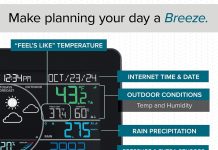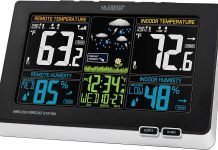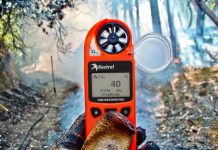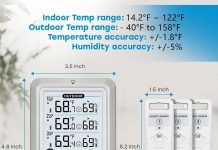Are you looking to stay updated on the latest weather conditions without stepping outside? Well, you’re in luck! We have the answer to your dilemma: a home weather station. But now comes the tough decision – should you go for a wired or wireless option? Before you get overwhelmed, let us break it down for you. In this article, we will explore the benefits of both wired and wireless home weather stations, helping you make the right choice for your weather-tracking needs. No more guessing what the weather has in store for you – let’s find out which option is the perfect fit for you!
Review contents
Factors to consider when choosing a home weather station
Choosing the right home weather station is an important decision for any weather enthusiast. There are several factors to consider when making this choice, as it will determine the accuracy, reliability, and convenience of your weather data. Let’s explore the key factors to consider before making your decision.
Accuracy
One of the most important factors to consider when choosing a home weather station is its accuracy. After all, the main purpose of a weather station is to provide accurate and reliable weather data. Both wired and wireless weather stations can provide accurate measurements, but it’s crucial to look for models that have a high degree of precision. Look for weather stations with sensors that are known for their accuracy and reliability.
Range
Another factor to consider is the range of the weather station. The range refers to the distance over which the weather station can transmit data. If you have a large property or if you want to place the weather station far away from your home, a wireless weather station with a long transmission range would be ideal. On the other hand, if you plan to place the weather station near your home, a wired weather station may be sufficient.
Installation
The ease of installation is an important factor to consider, especially for those who are not technically inclined. Wired weather stations typically require more complex installation as they involve running wires from the sensors to the display console. This may involve drilling holes in walls or running wires through the house. On the other hand, wireless weather stations are much easier to install as they do not require any wiring. They can be set up in minutes and start transmitting data right away.
Maintenance
Maintenance is another aspect that should not be overlooked when choosing a home weather station. Wired weather stations generally require less maintenance as there are no batteries or wireless components that need regular attention. Wireless weather stations, on the other hand, may require occasional battery replacement or recharging. It’s important to consider the maintenance requirements and ensure that you are willing to invest the time and effort required to keep the weather station in good working condition.
Flexibility
Flexibility in terms of placement is an important consideration when choosing a home weather station. Wired weather stations have limited placement options due to the need for physical wiring connections. This means that the sensors and display console must be in relatively close proximity to each other. On the other hand, wireless weather stations offer more flexibility as they do not require any physical connections. This allows you to place the sensors in various locations around your property for more accurate and comprehensive weather data.
Cost
Cost is always a significant factor to consider when making any purchase, and home weather stations are no exception. Wired weather stations often have a lower upfront cost as they do not require wireless components. However, there may be additional costs associated with the wiring and installation process. On the other hand, wireless weather stations may have a higher initial cost due to the wireless technology involved. It’s important to consider your budget and weigh the upfront cost against the long-term benefits before making a decision.
Ease of Use
The ease of use is another important factor to consider, especially if you are not tech-savvy. Wired weather stations may have a steeper learning curve as they often require more technical knowledge for installation and operation. On the other hand, wireless weather stations are generally more user-friendly. They come with intuitive interfaces and simple set-up processes that allow anyone to start using them with ease.
Data Transfer
One of the key advantages of a home weather station is the ability to transfer weather data to your computer, smartphone, or other devices. Wired weather stations often have limited data transfer options, as they typically rely on wired connections to transmit data. On the other hand, wireless weather stations offer extensive data transfer capabilities. They can connect wirelessly to your devices, allowing you to access real-time weather data from anywhere with an internet connection.
Integration with Other Devices
If you already have a smart home system or other weather-related devices, it’s important to consider the integration capabilities of the weather station you choose. Wired weather stations may have limited integration options, as they often rely on proprietary software and connections. Wireless weather stations, on the other hand, are more likely to have compatibility with a wide range of devices and platforms. This allows for seamless integration and data sharing between your weather station and other devices.
Power Source
The power source is an important factor to consider, especially if you live in an area prone to power outages. Wired weather stations often rely on a constant power supply from the electrical grid, which means they will continue to operate even during power outages. On the other hand, wireless weather stations generally rely on batteries or solar power. While this provides flexibility in terms of placement, it also means that they are dependent on a steady power source. It’s important to consider the availability and reliability of power sources in your area before choosing a weather station.
Advantages of a wired home weather station
Now, let’s delve into the specific advantages of a wired home weather station to help you make an informed decision.
Accuracy
Wired home weather stations are known for their superior accuracy. The physical wiring connections between the sensors and the display console ensure that the data is transmitted without interference or loss. This direct connection eliminates the potential for signal interference and ensures that the measurements are precise and reliable.
Range
While wired weather stations may have limited placement options, they do not face the range limitations of wireless weather stations. Wired connections can transmit data over longer distances without any loss, which is especially beneficial if you have a large property or if you want to place the sensors far away from your home.
Reliability
Reliability is a key advantage of wired weather stations. With physical wiring connections, there is no risk of signal loss or interference due to external factors such as electronic devices or weather conditions. This ensures that you receive accurate and consistent weather data at all times.
Secure Data Transmission
Wired weather stations provide secure data transmission as the data is transmitted through physical connections. This reduces the risk of interception or hacking, ensuring that your weather data remains private and confidential.
Longevity
Wired weather stations have a longer lifespan compared to their wireless counterparts. Without the need for batteries or wireless components, there are fewer components that can fail or degrade over time. This means that a well-maintained wired weather station can provide accurate weather data for many years.
No Batteries Required
One of the advantages of a wired weather station is that it does not require any batteries. This eliminates the need for regular battery replacements or recharging, saving you both time and money in the long run.
Simple Installation
While the installation of a wired weather station may be more complex compared to a wireless weather station, it is relatively simple for anyone with basic technical skills. Once the sensors are mounted and the wiring connections are made, the installation is complete and the weather station is ready to provide accurate weather data.
Lower Cost
Wired weather stations often have a lower upfront cost compared to wireless weather stations. As there are no wireless components involved, the price of a wired weather station may be more budget-friendly, especially for those who are just starting in their weather monitoring journey.
Compatibility
Wired weather stations are generally more compatible with older systems and devices. If you have existing weather monitoring equipment or software, a wired weather station is more likely to integrate seamlessly with your current setup.
No Interference
With wired weather stations, there is no risk of signal interference from electronic devices or other wireless systems. This ensures that the weather data collected is not compromised by external factors, providing you with accurate and reliable measurements.
Disadvantages of a wired home weather station
While there are many advantages to choosing a wired home weather station, it’s important to also consider the drawbacks before making your decision.
Limited Placement Options
One of the main drawbacks of a wired weather station is the limited placement options. The physical wiring connections between the sensors and the display console can restrict the distance between them. This means that the sensors and the display console need to be relatively close to each other, limiting the placement possibilities.
Wiring Requirements
Wired weather stations require wiring connections between the sensors and the display console. This may involve drilling holes in walls, running wires through the house, or using conduit to protect the wires. This can be a complex and time-consuming process, especially if you are not familiar with electrical work.
Complex Installation
The installation process for a wired weather station can be more complex compared to a wireless weather station. It involves mounting the sensors, running the wiring connections, and setting up the display console. This process may require technical knowledge or assistance, especially for those who are not comfortable with electrical work.
Physical Limitations
The physical wiring connections of a wired weather station can pose limitations on the placement of the sensors and display console. This can be challenging if you have specific areas or structures where you want to gather weather data. The physical constraints may not allow for optimal sensor placement in those areas.
Risk of Damage
With a wired weather station, there is a risk of damage to the wiring connections. The wires may get accidentally severed or damaged, resulting in the loss of data transmission. It’s important to take precautions and ensure that the wiring is protected and secured to minimize the risk of damage.
Not Portable
Wired weather stations are not portable, as the sensors and display console are permanently connected through physical wiring. Once installed, it is not easy to relocate the weather station to a different location. This may be a drawback for those who need to move their weather station due to changing environments or circumstances.
Limited Data Transfer
Wired weather stations generally have limited options for data transfer compared to wireless weather stations. With physical connections, the data can only be transmitted to a limited number of devices or systems that are directly connected to the weather station. This may limit your ability to access and analyze your weather data from multiple devices or platforms.
Advantages of a wireless home weather station
Now, let’s explore the advantages of a wireless home weather station to help you further evaluate your options.
Flexibility in Placement
One of the main advantages of a wireless weather station is the flexibility it offers in terms of sensor placement. Without the need for physical wiring connections, the sensors can be placed in various locations around your property to collect comprehensive and accurate weather data. This flexibility allows you to gather data from different areas, providing a more complete picture of the local weather conditions.
Ease of Installation
Wireless weather stations are known for their ease of installation. They do not require any wiring connections, drilling holes, or running wires through your home. With wireless weather stations, you can simply mount the sensors in the desired locations and set up the display console. This makes the installation process quick and hassle-free, even for those with limited technical knowledge.
Portability
Unlike wired weather stations, wireless weather stations are portable. The absence of physical connections allows you to easily move the sensors and display console to a different location if needed. This can be particularly beneficial if you plan to move or if you want to gather weather data from different areas over time.
Expanded Range
Wireless weather stations offer an expanded range compared to wired weather stations. With wireless technology, the sensors can transmit data wirelessly to the display console over greater distances. This is advantageous if you have a large property or if you want to monitor weather conditions in areas that are far away from your home.
Multiple Sensors
Many wireless weather stations come with the option to add multiple sensors. This allows you to gather data from different locations or areas simultaneously. For example, you can install additional sensors in your garden, greenhouse, or other specific areas of interest, providing you with more comprehensive weather data.
Convenience
Wireless weather stations offer convenience in terms of data access and monitoring. Most wireless weather stations allow you to access your weather data remotely through your computer, smartphone, or other internet-connected devices. This means that you can conveniently check the weather conditions from anywhere, anytime, without having to go to the physical display console.
Real-time Data Updates
With a wireless weather station, you can receive real-time updates on the weather conditions. The wireless transmission allows for instant data transfer, ensuring that you have the most up-to-date and accurate information at all times. This is particularly useful if you rely on weather data for planning outdoor activities or making weather-related decisions.
Disadvantages of a wireless home weather station
While wireless home weather stations offer many advantages, there are also some disadvantages that need to be considered.
Reliability
Reliability can be a concern with wireless weather stations. Wireless data transmission is susceptible to signal interruptions or loss due to various factors such as electronic devices, weather conditions, or interference from other wireless systems. This can result in inconsistent or inaccurate weather data.
Battery Dependence
Wireless weather stations rely on batteries or solar power to operate. This means that you need to regularly replace or recharge the batteries to ensure uninterrupted operation. If the batteries run out or are not replaced in time, there is a risk of losing weather data or experiencing gaps in data transmission.
Signal Interference
Wireless weather stations can be prone to signal interference from electronic devices or other wireless systems in the vicinity. This interference can disrupt the data transmission and result in inaccurate or incomplete weather data. It’s important to consider the potential sources of interference and choose a weather station that operates on a frequency or channel with minimal interference.
Reduced Accuracy
Wireless weather stations may experience reduced accuracy compared to wired weather stations. The wireless data transmission can introduce slight errors or discrepancies in the measurements due to signal loss or interference. While the difference in accuracy may be minimal for most users, it’s important to consider the level of accuracy required for your specific needs.
Vulnerable to Hacking
Wireless weather stations that connect to the internet for remote data access are potentially vulnerable to hacking or unauthorized access. It’s important to choose a weather station that has robust security features and encryption protocols to protect your weather data from being compromised.
Limited Lifespan
Battery-powered wireless weather stations have a limited lifespan compared to wired weather stations. The batteries need to be replaced or recharged regularly, and over time, they may degrade and lose their capacity. This may result in reduced performance or the need for frequent battery replacements.
Higher Cost
Wireless home weather stations generally have a higher upfront cost compared to wired weather stations. The wireless technology involved, along with the additional components such as batteries or solar panels, contribute to the higher price tag. It’s important to consider your budget and weigh the benefits against the cost before making a decision.
Data Loss Risk
Wireless weather stations rely on uninterrupted data transmission to provide accurate and real-time weather updates. However, there is a risk of data loss if the wireless signal is weak or if there are disruptions in the transmission. This can result in gaps in the weather data or delays in receiving updates.
Limited Compatibility
Wireless weather stations may have limited compatibility with older systems or devices. They often rely on wireless protocols and may not be compatible with older software or equipment. If you have existing weather monitoring systems or devices, it’s important to ensure that they are compatible with the wireless weather station you choose.
Maintenance Requirements
Wireless weather stations may require more frequent maintenance compared to wired weather stations. This includes regular battery replacement or recharging, ensuring that wireless connections remain secure, and troubleshooting any signal or data transmission issues. It’s important to consider the maintenance requirements and factor them into your decision-making process.
Benefits of a wired home weather station
To summarize the advantages of a wired home weather station:
Superior Accuracy
Wired weather stations are known for their superior accuracy due to the direct physical connections between the sensors and the display console. This ensures accurate and reliable weather data, making them a preferred choice for weather enthusiasts who require precise measurements.
Secure Data Transmission
With wired connections, data transmission in a wired weather station is secure and less susceptible to interception or hacking. This ensures that your weather data remains private and confidential.
No Batteries Required
Wired weather stations do not require batteries for operation. This eliminates the need for regular battery replacements or recharging, saving you both time and money in the long run.
Longevity
Wired weather stations have a longer lifespan compared to wireless weather stations. With fewer components that can fail or degrade over time, a well-maintained wired weather station can provide accurate weather data for many years.
Lower Cost
Wired weather stations often have a lower upfront cost as they do not require wireless components. This can be beneficial for those who are on a budget or are just starting in their weather monitoring journey.
More Compatibility
Wired weather stations are generally more compatible with older systems and devices. If you have existing weather monitoring equipment or software, a wired weather station is more likely to integrate seamlessly with your current setup.
Benefits of a wireless home weather station
To summarize the advantages of a wireless home weather station:
Flexibility in Placement
Wireless weather stations offer flexibility in terms of sensor placement. Without the need for physical wiring connections, the sensors can be placed in various locations to collect comprehensive and accurate weather data.
Ease of Installation
Wireless weather stations are easy to install, requiring no wiring connections. Simply mount the sensors in the desired locations and set up the display console to start receiving weather data.
Portability
Wireless weather stations are portable, allowing you to easily move the sensors and display console to a different location if needed.
Expanded Range
Wireless weather stations have an expanded range compared to wired weather stations, allowing data transmission over greater distances. This is beneficial for those who have large properties or want to monitor weather conditions in distant areas.
Convenience
Wireless weather stations offer convenience in terms of data access and monitoring. Most wireless weather stations allow you to access your weather data remotely through your computer, smartphone, or other internet-connected devices.
Real-time Data Updates
With a wireless weather station, you can receive real-time updates on the weather conditions, ensuring that you have the most up-to-date and accurate information.
Drawbacks of a wired home weather station
To summarize the drawbacks of a wired home weather station:
Limited Placement Options
Wired weather stations have limited placement options due to the physical wiring connections. The proximity between the sensors and the display console may restrict the possible locations for installation.
Complex Installation
The installation process for a wired weather station can be complex, involving mounting the sensors, running wiring connections, and setting up the display console. This may require technical knowledge or assistance.
Physical Limitations
Wired weather stations have physical limitations due to the wiring connections. This may pose challenges if you want to gather weather data from specific areas or structures that are not easily accessible.
Risk of Damage
The wiring connections in a wired weather station can be susceptible to damage. Accidental severing or damage to the wires may result in the loss of data transmission.
Not Portable
Wired weather stations are not portable, as the sensors and display console are permanently connected through physical wiring. Relocating the weather station to a different location is not easy once installed.
Drawbacks of a wireless home weather station
To summarize the drawbacks of a wireless home weather station:
Reliability
Wireless weather stations may face reliability issues due to signal interruptions or loss. Factors such as electronic devices, weather conditions, or interference from other wireless systems can disrupt the data transmission and result in inconsistent or inaccurate weather data.
Battery Dependence
Wireless weather stations rely on batteries or solar power for operation. Regular battery replacement or recharging is necessary to ensure continuous and uninterrupted operation.
Signal Interference
Wireless weather stations are prone to signal interference from electronic devices or other wireless systems in the vicinity. This interference can disrupt the data transmission and result in inaccurate or incomplete weather data.
Reduced Accuracy
Wireless weather stations may experience slightly reduced accuracy compared to their wired counterparts due to signal loss or interference during data transmission.
Vulnerable to Hacking
Wireless weather stations that connect to the internet for remote data access are potentially vulnerable to hacking or unauthorized access. It’s important to choose a weather station with robust security features to protect your weather data from being compromised.
Conclusion
Choosing between a wired or wireless home weather station can be a tough decision, but it’s important to consider your specific needs and requirements. Here are some key points to consider before making a decision:
Consider Your Needs
Think about the specific features and capabilities that are important to you. Do you prioritize accuracy, range, data transfer, or ease of use? Understanding your needs will help you narrow down your options and choose the right weather station for you.
Evaluate Location and Placement
Consider the location and placement options for your weather station. Do you have a large property or specific areas where you want to gather weather data? Assessing these factors will help determine whether a wired or wireless weather station is more suitable for your needs.
Budget Considerations
Consider your budget and weigh the benefits against the cost. Wired weather stations often have a lower upfront cost, but additional expenses may be incurred during installation. Wireless weather stations may have a higher initial cost but offer more flexibility and convenience.
Assess Your Technical Expertise
Consider your technical expertise and comfort level with installation and maintenance. Wired weather stations require more technical knowledge for installation, while wireless weather stations are generally more user-friendly. Choose a weather station that aligns with your technical skills and abilities.
Consider Long-Term Growth
Think about your long-term plans and growth potential. Do you anticipate expanding your weather monitoring capabilities or integrating your weather station with other devices or systems? Choosing a weather station that allows for growth and compatibility will provide you with flexibility in the future.
By carefully evaluating these factors, you can make an informed decision and choose the home weather station that best suits your needs. Whether you opt for a wired or wireless weather station, having accurate and reliable weather data at your fingertips will enhance your understanding of the local weather conditions and enable you to make informed decisions based on the forecast.



























